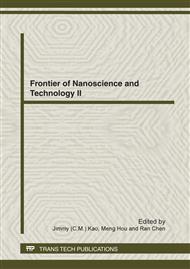p.117
p.121
p.126
p.130
p.135
p.140
p.144
p.152
p.156
Effect of Temperatures on Tensile of Aluminium Thin Films
Abstract:
The mechanical process of single-crystal aluminium thin films under uniaxial tensile strain was simulated with molecular dynamics method at different temperature. The stress–strain curve and potential energy–strain curve of thin aluminium film under uniaxial tensile deformation were obtained by molecular dynamics simulations. With the changes of sample temperatures in uniaxial extension, the variation characteristics of stress–strain curves are alike at the elastic stage and different at the plastic one below and above 370 K, respectively. From the stress–strain curves, we gained the first local maximum stress-temperature curve and the strain at the first local maximum stress-temperature curve, and found that the strange temperature dependence of first local maximum stress: when the temperature is above 370 K, the stress goes down quickly with temperature, and when below 370 K, it descends slowly. With increasing temperature, the difference between two strain values corresponding to two maximal potential energies changes slowly below and above 370K but it goes up quickly about 370K. By these dependences, we have identified the critical temperature (370K) for the transition of plastic flow mechanism.
Info:
Periodical:
Pages:
135-139
Citation:
Online since:
June 2012
Authors:
Price:
Сopyright:
© 2012 Trans Tech Publications Ltd. All Rights Reserved
Share:
Citation:


